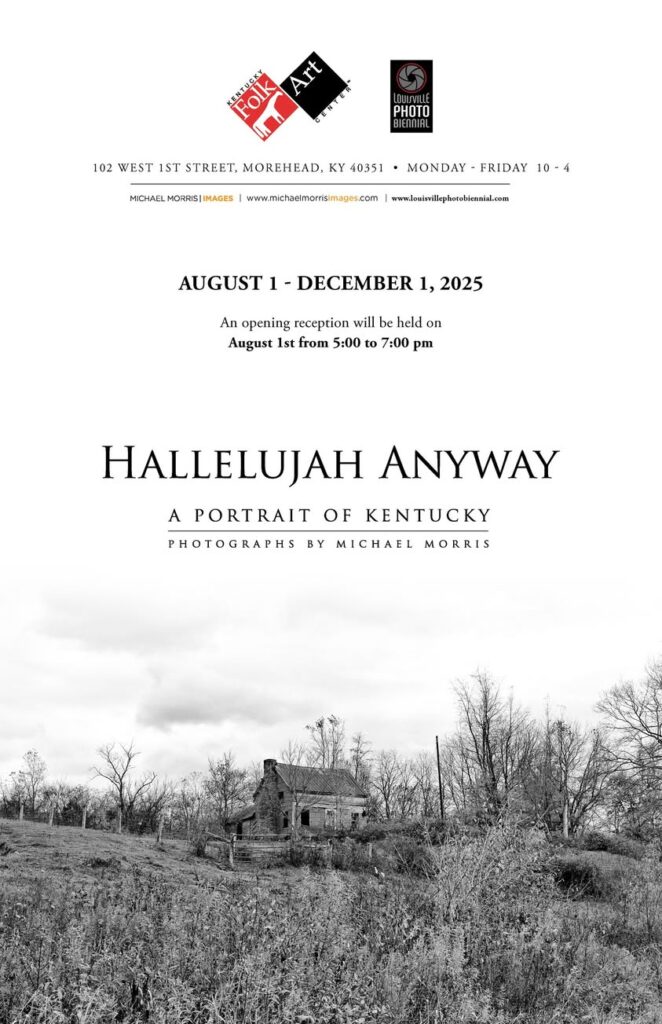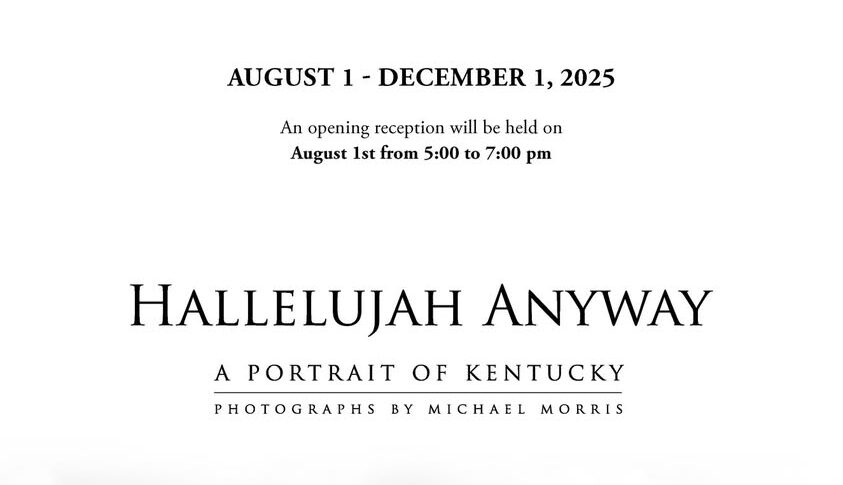By Mike Templeton
Part of telling the story of urban Appalachians involves remaining acutely aware of how Appalachia is represented by contemporary photographers. Our story is complex, and some of the best Appalachian photographers know how to present this complexity. This is one of many reasons why the Urban Appalachian Community Coalition is so supportive of Appalachian photographers. You may recall our profile of Appalachian photographer Malcolm Wilson whose work appears as a central feature of our own Kith and Kin: Appalachians and the Making of Cincinnati, and whose work also forms the basis of the “Humans of Central Appalachia” project. Morehead State University will be the place to see more Appalachian photography, and this exhibit offers powerful window into rural folk life of Appalachian Kentucky.
The Kentucky Folk Art Center at Morehead State University just hosted the opening for an exhibition of photographs by Kentucky photographer Michael Morris. These are images of rural and folk life from all over Kentucky, including the Appalachian region. The exhibit will run until December 1, so there is plenty of time to catch the show. The Kentucky Folk Art Center houses a permanent collection of nearly 1,400 pieces of regional folk art, which portrays the culture and heritage of Appalachia. It is one of the premier resources of the folk and cultural life of Appalachian Kentucky, and this current exhibition is a powerful addition to an already compelling collection. The exhibition is titled “Hallelujah Anyway: A Portrait of Kentucky, Photography by Michael Morris” and it is a magnificent collection of images from a renowned Kentucky photographer.

Michael Morris is a Louisville-based photographer who has, since 2011, focused his lens exclusively on documenting the rural life of Kentucky. His work documents people, places, and things which he sees as the defining elements of the Commonwealth of Kentucky. The agricultural and mountain cultures that built the state are deeply embedded in the hearts of Kentuckians and those who have ties to the state and its regions, including many urban Appalachians who carry the rural life of Kentucky with them. Morris relies on an old Hasselblad medium format camera, something that should appeal to the old-fashioned photography purists but also to anyone who enjoys getting lost in the depth and texture of black and white photography.
Morris’s photographic work focuses on those aspects of Kentucky folk life that are disappearing before our eyes. The features of rural life so closely aligned with our understandings of folk life are being overtaken by modern ways of farming and the ever-growing homogenization of cultural more generally. His images show us things that are quite common in so many ways, but the strain of the decades is written all over the objects in these images. The aged picket fence that partially surrounds an old country church shows the flaking paint and the decay from the years even as both the fence and the church still stand firmly planted in the ground. It is a visual metaphor for rural life which carries the weight of the years while standing up to all that has come its way over the years. In another photo, as if to bring the feelings evoked from the fence and the church to life, we look into the face of a weathered older man who wears his years and his strength so defiantly yet peacefully. The wrinkles on his face are a text in themselves that tell the story of a lifetime working a small mountain farm.
It is curious that the announcement for the exhibition uses the term “nostalgia” while explaining the potential problems with this word. Nostalgia can indicate a genuine love for an ideal past that we embrace with a sense of celebration. It can also imply a distortion of historical facts. In looking through Morris’s photographs, I would characterize them as having an idealizing quality, but there is nothing about these images that appear to be a distortion of the facts. There is a photograph of a haycart in front of what appears to be an old country manor house. Both the cart, the house, and the surrounding land appear to have seen better days. Morris does not shy away from a certain amount of decay in the ways he presents rural life in Kentucky. At the same time, he appears to be just as committed to revealing the tenacity of these rural spaces and people. This is not a distortion of the facts but an honest portrayal of Appalachian life.
Michael Morris captures something more than just artifacts in his photographs. Each image reveals a world in itself, the lives of people who never made the headlines or the tv news but who labored quietly on the land and in small Kentucky towns. Their spaces and places, their homes, barns, and gathering places, and even the ground itself all form some part of the rural people captured in Morris’s work. This exhibition is a powerful commentary on who we are, and for urban Appalachians, it offers poignant reminders of where we came from. These kinds of works have been an inspiration to artists and writers associated with the Urban Appalachian Community Coalition. The exhibition is worth a road trip to Morehead, Kentucky. You can check out the exhibition of images by Kentucky photographer Michael Morris at the Kentucky Folk Art Center at Morehead State University through December 1.
Complete information about the exhibition, “Hallelujah Anyway: A Portrait of Kentucky. Photography by Michael Morris” can be found at this link: www.moreheadstate.edu/events/recurring/kfac-kentucky-portrait-gallery.
More information on the Kentucky Folk Art Center can be found at this link: www.moreheadstate.edu/academics/colleges/humanities/kentucky-folk-art-center.
You can follow the Kentucky Folk Art Center on their Facebook at this link: www.facebook.com/kyfolkart.

